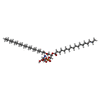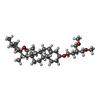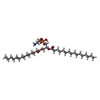登録情報 データベース : EMDB / ID : EMD-29082タイトル Cryo-EM structure of human voltage-gated sodium channel Nav1.6 Cryo-EM structure of human voltage-gated sodium channel Nav1.6 複合体 : Complex of human voltage-gated sodium channel Nav1.6 with auxiliary beta-1 subunitタンパク質・ペプチド : Sodium channel protein type 8 subunit alphaタンパク質・ペプチド : Sodium channel subunit beta-1リガンド : 2-acetamido-2-deoxy-beta-D-glucopyranoseリガンド : CHOLESTEROL HEMISUCCINATEリガンド : CHOLESTEROLリガンド : 1-O-OCTADECYL-SN-GLYCERO-3-PHOSPHOCHOLINEリガンド : 1,2-DIOLEOYL-SN-GLYCERO-3-PHOSPHOCHOLINEリガンド : O-[(R)-{[(2R)-2,3-bis(octadecanoyloxy)propyl]oxy}(hydroxy)phosphoryl]-L-serineリガンド : (3beta,14beta,17beta,25R)-3-[4-methoxy-3-(methoxymethyl)butoxy]spirost-5-enリガンド : (5E,17R,20S)-23-amino-20-hydroxy-14,20-dioxo-15,19,21-trioxa-20lambda~5~-phosphatricos-5-en-17-yl hexadecanoate / / 機能・相同性 分子機能 ドメイン・相同性 構成要素
/ / / / / / / / / / / / / / / / / / / / / / / / / / / / / / / / / / / / / / / / / / / / / / / / / / / / / / / / / / / / / / / / / / / / / / / / / / / / / / / / / / / / 生物種 Homo sapiens (ヒト)手法 / / 解像度 : 3.1 Å Fan X / Huang J / Yan N 資金援助 Organization Grant number 国 Human Frontier Science Program (HFSP) LT000754
ジャーナル : Proc Natl Acad Sci U S A / 年 : 2023タイトル : Cryo-EM structure of human voltage-gated sodium channel Na1.6.著者 : Xiao Fan / Jian Huang / Xueqin Jin / Nieng Yan / 要旨 : Voltage-gated sodium channel Na1.6 plays a crucial role in neuronal firing in the central nervous system (CNS). Aberrant function of Na1.6 may lead to epilepsy and other neurological disorders. ... Voltage-gated sodium channel Na1.6 plays a crucial role in neuronal firing in the central nervous system (CNS). Aberrant function of Na1.6 may lead to epilepsy and other neurological disorders. Specific inhibitors of Na1.6 thus have therapeutic potentials. Here we present the cryo-EM structure of human Na1.6 in the presence of auxiliary subunits β1 and fibroblast growth factor homologous factor 2B (FHF2B) at an overall resolution of 3.1 Å. The overall structure represents an inactivated state with closed pore domain (PD) and all "up" voltage-sensing domains. A conserved carbohydrate-aromatic interaction involving Trp302 and Asn326, together with the β1 subunit, stabilizes the extracellular loop in repeat I. Apart from regular lipids that are resolved in the EM map, an unprecedented Y-shaped density that belongs to an unidentified molecule binds to the PD, revealing a potential site for developing Na1.6-specific blockers. Structural mapping of disease-related Na1.6 mutations provides insights into their pathogenic mechanism. 履歴 登録 2022年12月14日 - ヘッダ(付随情報) 公開 2023年2月8日 - マップ公開 2023年2月8日 - 更新 2024年11月13日 - 現状 2024年11月13日 処理サイト : RCSB / 状態 : 公開
すべて表示 表示を減らす
 データを開く
データを開く 基本情報
基本情報
 マップデータ
マップデータ 試料
試料 キーワード
キーワード 機能・相同性情報
機能・相同性情報 Homo sapiens (ヒト)
Homo sapiens (ヒト) データ登録者
データ登録者 フランス, 1件
フランス, 1件  引用
引用 ジャーナル: Proc Natl Acad Sci U S A / 年: 2023
ジャーナル: Proc Natl Acad Sci U S A / 年: 2023

 構造の表示
構造の表示 ダウンロードとリンク
ダウンロードとリンク emd_29082.map.gz
emd_29082.map.gz EMDBマップデータ形式
EMDBマップデータ形式 emd-29082-v30.xml
emd-29082-v30.xml emd-29082.xml
emd-29082.xml EMDBヘッダ
EMDBヘッダ emd_29082_fsc.xml
emd_29082_fsc.xml FSCデータファイル
FSCデータファイル emd_29082.png
emd_29082.png emd_29082_msk_1.map
emd_29082_msk_1.map マスクマップ
マスクマップ emd-29082.cif.gz
emd-29082.cif.gz emd_29082_half_map_1.map.gz
emd_29082_half_map_1.map.gz emd_29082_half_map_2.map.gz
emd_29082_half_map_2.map.gz http://ftp.pdbj.org/pub/emdb/structures/EMD-29082
http://ftp.pdbj.org/pub/emdb/structures/EMD-29082 ftp://ftp.pdbj.org/pub/emdb/structures/EMD-29082
ftp://ftp.pdbj.org/pub/emdb/structures/EMD-29082 emd_29082_validation.pdf.gz
emd_29082_validation.pdf.gz EMDB検証レポート
EMDB検証レポート emd_29082_full_validation.pdf.gz
emd_29082_full_validation.pdf.gz emd_29082_validation.xml.gz
emd_29082_validation.xml.gz emd_29082_validation.cif.gz
emd_29082_validation.cif.gz https://ftp.pdbj.org/pub/emdb/validation_reports/EMD-29082
https://ftp.pdbj.org/pub/emdb/validation_reports/EMD-29082 ftp://ftp.pdbj.org/pub/emdb/validation_reports/EMD-29082
ftp://ftp.pdbj.org/pub/emdb/validation_reports/EMD-29082
 F&H 検索
F&H 検索 リンク
リンク EMDB (EBI/PDBe) /
EMDB (EBI/PDBe) /  EMDataResource
EMDataResource マップ
マップ ダウンロード / ファイル: emd_29082.map.gz / 形式: CCP4 / 大きさ: 125 MB / タイプ: IMAGE STORED AS FLOATING POINT NUMBER (4 BYTES)
ダウンロード / ファイル: emd_29082.map.gz / 形式: CCP4 / 大きさ: 125 MB / タイプ: IMAGE STORED AS FLOATING POINT NUMBER (4 BYTES) emd_29082_msk_1.map
emd_29082_msk_1.map 試料の構成要素
試料の構成要素 解析
解析 試料調製
試料調製 電子顕微鏡法
電子顕微鏡法 FIELD EMISSION GUN
FIELD EMISSION GUN
 ムービー
ムービー コントローラー
コントローラー









 Z (Sec.)
Z (Sec.) Y (Row.)
Y (Row.) X (Col.)
X (Col.)





















































